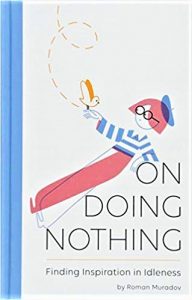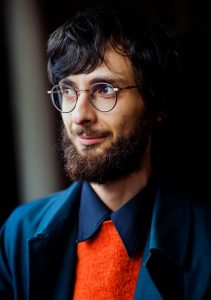calsfoundation@cals.org
Arkansas Literary Festival: Roman Muradov
The sixteenth annual Arkansas Literary Festival will take place April 25-28, 2019.
Artist Roman Muradov Finds the Secret of the Creative Process in On Doing Nothing
 The title of Roman Muradov’s latest book, On Doing Nothing: Finding Inspiration in Idleness, might suggest that this 96-page book will be a whimsical ode to downtime on the couch, with humorous illustrations. The book does include illustrations by the author, who is an award-winning artist. And the illustrations are witty, though in a mind-bending way that invites a second look, and a third. What initially seems like a simple line drawing reveals much more in the details, with imaginative design and a sly sense of humor.
The title of Roman Muradov’s latest book, On Doing Nothing: Finding Inspiration in Idleness, might suggest that this 96-page book will be a whimsical ode to downtime on the couch, with humorous illustrations. The book does include illustrations by the author, who is an award-winning artist. And the illustrations are witty, though in a mind-bending way that invites a second look, and a third. What initially seems like a simple line drawing reveals much more in the details, with imaginative design and a sly sense of humor.
Just as surprising is the text. If you are a reader or a creative, Muradov’s book is possibly the most stimulating, thought-packed, inspiring meditation you will pick up this year. It has a six-page bibliography. Can you remember the last time you read a gift book with a bibliography? And what a range of citations: everything from Flannery O’Connor to Baudelaire to Seinfeld and tweets from Ted Cruz. But somehow, these wildly divergent references blend into a reading experience that invites the contemplation Muradov loves. You can read one page of this book, set it down, and feel fully satisfied for an hour of thought. Or daydreaming.
On Doing Nothing is a book that belongs on the coffee table of everyone who loves reading, as well as everyone who wants to float through the luxurious empty spaces that enable the creative process.
Award-winning artist also has a gift with words
The fact that an award-winning visual artist can also produce a deep, eloquent meditation on creativity is impressive—and even more so because his writing has a relaxed rhythm that is pleasant to read. Most people come into the world with, at most, one prodigious gift, but Muradov is clearly as talented with words as he is with imagery.
“This is my first nonfiction work,” he said. “The departure was liberating.” As a college-level art instructor in California, he spends most of his time immersed in the creative process for visual art. His previously published books have been graphic novels, so writing a book with less visual content felt easier to him. “Writing comes more naturally than art sometimes, and there is much more opportunity to revise and polish than in drawing, so it’s a less risky performance,” he said.
To Muradov, visual art is more arduous and less intuitive than writing. “A lot of it is born from idle contemplation, but it’s a huge amount of work,” he said. “With writing, I hear a voice and transcribe it. Drawing can sometimes have that fluidity, but it’s more rare. I try to do my creative drawing in the morning because I’m less awake and less prone to self-editing.”
 Muradov’s work as a teacher offered him ample opportunity to observe the creative process for his students. “The book came out of what I’ve observed over the years by teaching arts students,” he said. “Students have to find a roundabout way. Most interesting ideas come when you take a roundabout route to allow yourself to get lost. I wouldn’t have written the book if I hadn’t seen that this method works. I leave the students a lot of free time compared to other instructors. And when I did that, I saw the students becoming much more creative and lively in their work.”
Muradov’s work as a teacher offered him ample opportunity to observe the creative process for his students. “The book came out of what I’ve observed over the years by teaching arts students,” he said. “Students have to find a roundabout way. Most interesting ideas come when you take a roundabout route to allow yourself to get lost. I wouldn’t have written the book if I hadn’t seen that this method works. I leave the students a lot of free time compared to other instructors. And when I did that, I saw the students becoming much more creative and lively in their work.”
The author, who spent his youth in Moscow and moved to the USA in his twenties, clearly knows creativity. The drawings that pop up every couple of pages are strikingly original and clever, the smart man’s version of whimsy. And interestingly, though most faces in these drawings are suggested with the barest hint of facial features, one of the few fully realized faces is that of a cat.
“Cats are probably the superior beings on this planet,” Muradov said on the subject. “I’ve never seen a creature more at ease with itself. I would like to be a cat, and not cursed with the overdrawn brain we humans have, that makes us do things for no reason.”
That one phrase, the “overdrawn brain,” can tell a lot about Muradov’s theme in this book, both in the writing and illustration. If our overdrawn brains can bask in the simplicity of idleness, of nothing-time, they can spiral out of that messy, overwrought thinking, until the clean, simpler lines of creative thought and art begin to emerge. Because “doing nothing,” according to Muradov, is not really idle. It’s a quiet slide into meditative thought.
This kind of thinking is contemplation, for which the word idleness does little justice.
“This kind of thinking,” Muradov said, “is contemplation, for which the word idleness does little justice.”
All artists, creatives, and lovers of the book can find Roman Muradov in person at the Arkansas Literary Festival, April 25-28, 2019.
Roman Muradov is an award-winning author and illustrator living in San Francisco. His work has appeared in the New Yorker, the New York Times, the Paris Review, Vogue, and Lucky Peach, among others. His books include On Doing Nothing, Vanishing Act, (In A Sense) Lost & Found, Jacob Bladders and the State of the Art and the End of A Fence, as well as the French collection Aujourd’hui Demain Hier. He has designed books for Penguin Random House, including the Penguin Classics Centennial Editions of James Joyce’s Dubliners and A Portrait of the Artist as a Young Man. He also has a couple of medals from the Society of Illustrators, and an imaginary dog named Barchibald.



